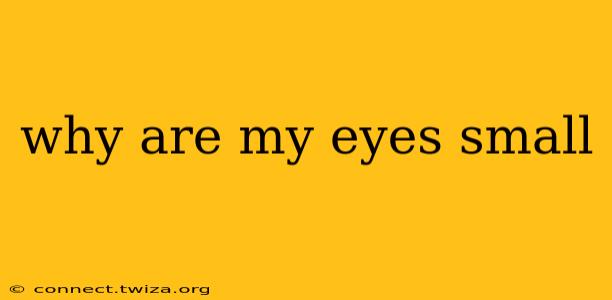Why Are My Eyes Small? Understanding Eye Size and Shape
Many people wonder why their eyes appear smaller than average. Eye size is a complex trait determined by a combination of genetics, ethnicity, and even aging. It's not necessarily something to worry about, but understanding the factors involved can help alleviate any concerns.
What Determines Eye Size?
Genetics: This is the most significant factor. Your eye size is largely inherited from your parents. Specific genes influence the size and shape of your eye sockets, eyelids, and the surrounding tissues, all of which contribute to the overall appearance of your eye size. If your parents have relatively small eyes, you're more likely to inherit that trait.
Ethnicity: Certain ethnic groups tend to have statistically different average eye sizes. This is simply a reflection of the genetic variations within different populations. It's important to note that this is a general trend, and there's a wide range of eye sizes within every ethnic group.
Aging: As we age, the skin around our eyes loses elasticity and can become more lax. This can lead to the eyelids appearing slightly heavier or droopy, potentially making the eyes seem smaller.
Muscle Tone: The muscles surrounding the eyes play a role in how open they appear. If these muscles are weak or underdeveloped, it might contribute to a perceived smaller eye size.
Are Small Eyes a Medical Concern?
Generally, small eyes themselves are not a medical concern. However, if you notice a sudden change in your eye size or shape, accompanied by other symptoms like:
- Double vision (diplopia)
- Pain or discomfort in your eyes
- Swelling or redness around your eyes
- Changes in vision (blurred vision, etc.)
it's crucial to consult an ophthalmologist or optometrist immediately. These symptoms could indicate an underlying medical condition that requires attention.
Can I Make My Eyes Appear Larger?
While you can't fundamentally change your eye size, there are cosmetic techniques that can create the illusion of larger eyes:
- Makeup: Strategic use of eyeliner, eyeshadow, and mascara can enhance the eyes and make them appear more open and larger.
- Hairstyle: Certain hairstyles can also frame the face and emphasize the eyes.
- Cosmetic Procedures: Procedures like blepharoplasty (eyelid surgery) can address drooping eyelids and potentially make the eyes appear larger. However, this should only be considered after thorough consultation with a qualified plastic surgeon.
What about Ptosis (Drooping Eyelid)?
H2: What is Ptosis (Drooping Eyelid)?
Ptosis, or drooping eyelid, is a condition that can make the eyes appear smaller. It can be caused by various factors, including muscle weakness, nerve damage, or age-related changes. If you suspect ptosis, consult an ophthalmologist for diagnosis and treatment options.
H2: Can Small Eyes Affect Vision?
Generally, the size of your eyes doesn't directly impact your vision. Your vision is primarily determined by the health of your eyes' internal structures, including the retina, lens, and cornea. However, certain conditions that might affect eye size, such as ptosis, can sometimes lead to vision problems. It's important to have regular eye exams to ensure your vision remains healthy.
This information is for general knowledge and does not constitute medical advice. If you have any concerns about your eye health, always consult a qualified healthcare professional.
